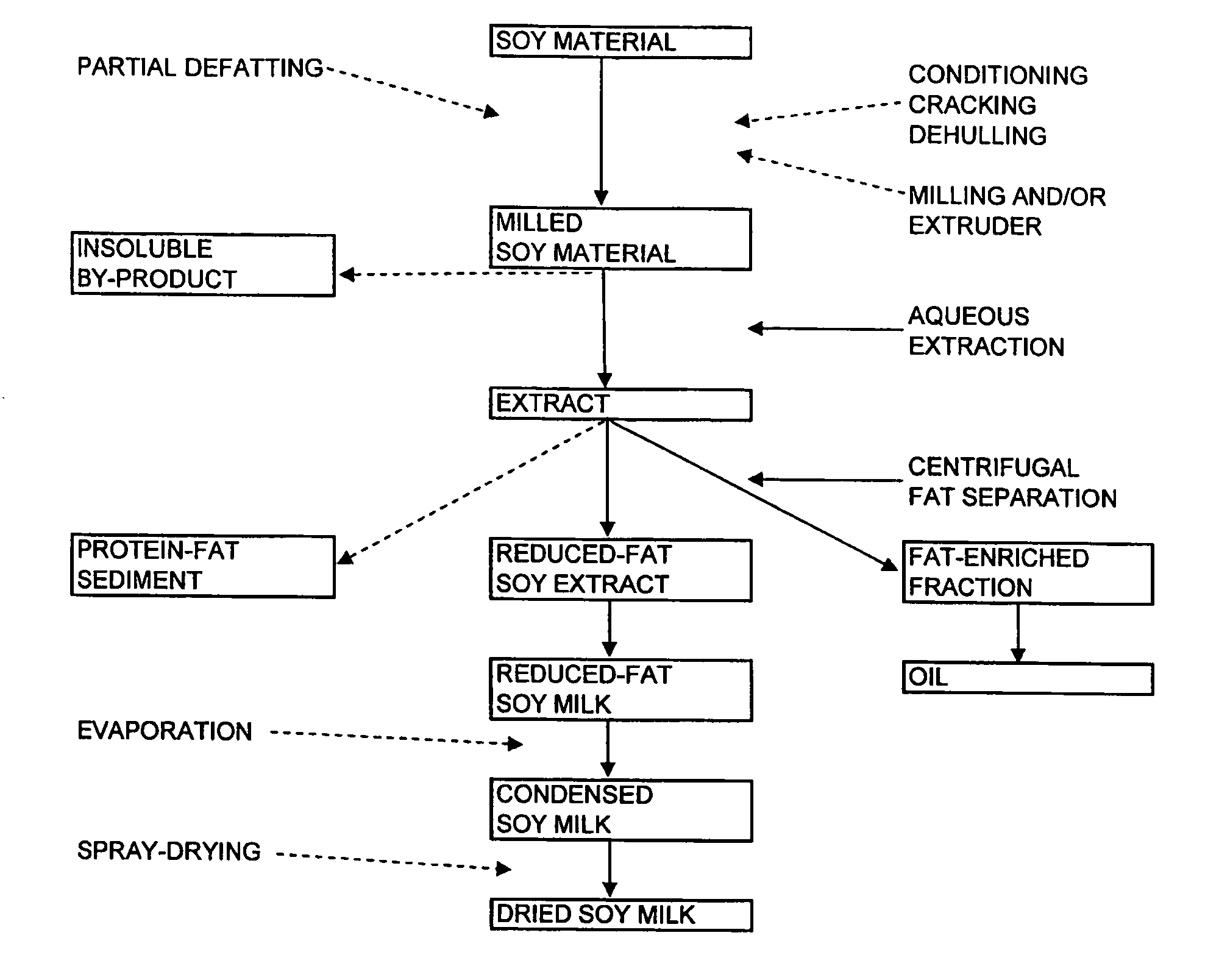Methods of separating fat from soy materials and compositions produced therefrom
a technology of which is applied in the field of methods of separating fat from soy materials and compositions produced therefrom, can solve the problems of inability to use, inability to consider natural solvents, and relatively inefficient oil recovery by extruder press methods
- Summary
- Abstract
- Description
- Claims
- Application Information
AI Technical Summary
Benefits of technology
Problems solved by technology
Method used
Image
Examples
example 1
Preparation of Reduced Fat Soy Protein Products from Extruder Pressed Soy Flour Using the Acid Precipitation Process
[0064]Partially defatted, extruder pressed soy flour was obtained from Natural Products, Inc., (lot number 092605, Grinnell, Iowa). Dehulled soybean pieces were partially defatted using a mechanical extruder-press (Instapro™ Dry Extruder and Continuous Horizontal Press, Des Moines, Iowa). The partially defatted soy cake was ground into a 100 mesh partially defatted soy flour with proximate analysis of 5.0% moisture, 54.0% dry basis Kjeldahl protein, 11.7% dry basis acid hydrolyzed fat and a 4.6 to 1 protein to fat ratio.
[0065]In this and all subsequent examples, the dry basis protein and fat ratios were measured by standard methods. The protein content of the soy materials was determined using the Kjeldahl method (AOAC 18th Ed. Method 991.2.2, Total Nitrogen in Milk, 1994, which is incorporated herein by reference in its entirety). Briefly, samples were digested using ...
example 2
Preparation of Reduced-Fat Soy Protein Compositions from High Pressure Liquid Extraction Soy Cake Using the Acid Precipitation Process
[0074]Partially defatted soy cake was obtained from SafeSoy Technologies (lot number SS, Ellsworth, Iowa). Dehulled soybean pieces were partially defatted using a high pressure liquid extractor (prototype model, Crown Iron Works, Minneapolis, Minn., See U.S. Patent Publication No. 2006 / 0211874). High pressure liquid extraction is a continuous screw press method using carbon dioxide as a solvent under high pressure, but less than super critical conditions, to remove fat from oilseeds. The partially defatted HPLE soy cake was milled to a flour as in Example 1 and had proximate analysis of 9.59% moisture, 52.1% dry basis Kjeldahl protein, and 6.6% dry basis acid hydrolyzed fat for a protein to fat ratio of 5.4 to 1.
[0075]Fifty pounds of the partially defatted soy flour was extracted with 800 pounds of water at 125° F. in a 100 gallon agitated tank. The p...
example 3
Preparation of Reduced-Fat Soy Protein Compositions from Full Fat Soy Flour Using the Acid Precipitation Process
[0080]Full fat soy flour was obtained from Natural Products Inc. (lot number 112105, Grinnell, Iowa), and was produced from certified organic whole soybeans. Dehulled soybean pieces were milled to 600 mesh flour using s microgrinding mill (model DNWA, Buhler, Minneapolis, Minn.). The resulting full fat soy flour contained 8.83% moisture, 43.9% dry basis Kjeldahl protein, and 25.5% dry basis acid hydrolyzed fat for a protein to fat ratio of 1.7 to 1.
[0081]Fifty pounds of full fat soy flour was extracted with 800 pounds of water at 125° F. in a 100 gallon agitated tank. The pH of the extraction slurry was adjusted to 9.35 by addition of 0.5 pound of calcium hydroxide and held for a mean time of 1 hour. The soy extract was separated from the insoluble by-product using a high g-force, disk-type clarifying centrifuge as described in Example 1. Ten pounds of insoluble by-product...
PUM
 Login to View More
Login to View More Abstract
Description
Claims
Application Information
 Login to View More
Login to View More - R&D
- Intellectual Property
- Life Sciences
- Materials
- Tech Scout
- Unparalleled Data Quality
- Higher Quality Content
- 60% Fewer Hallucinations
Browse by: Latest US Patents, China's latest patents, Technical Efficacy Thesaurus, Application Domain, Technology Topic, Popular Technical Reports.
© 2025 PatSnap. All rights reserved.Legal|Privacy policy|Modern Slavery Act Transparency Statement|Sitemap|About US| Contact US: help@patsnap.com



